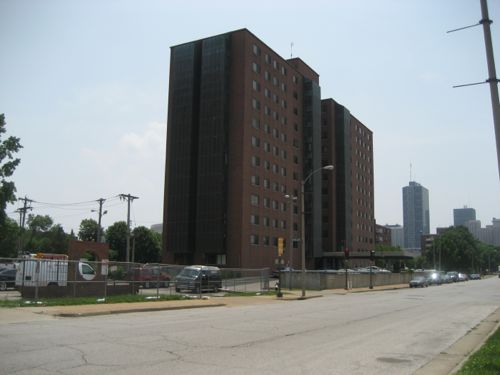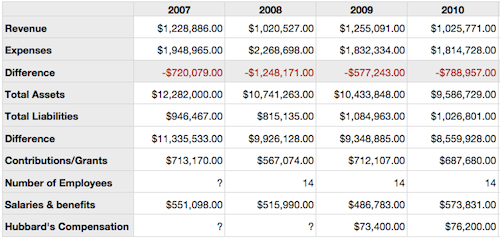Non-Profit Carr Square Tenant Corporation Has Massive Annual Deficits
Tenant management of public housing projects was a new thing forty years ago:
In 1971, brought together by frustration with poor management and maintenance, the residents of the Bromley-Heath public housing development In Boston formally Incorporated the nation’s first resident management corporation That same year, St. Louis’ public housing residents waged a rent strike against their housing authority to protest poor maintenance and rising rents In the wake of the strike settlement, the authority eventually delegated control over a number of management functions to newly-formed resident organizations at several Sites, Including Carr Square and Cochran Gardens. These events marked the beginning of the resident management movement, which today is viewed by resident advocates and policy makers as a potential solution to many of the problems facing America’s public housing stock and the people who live In it. (HUD – Evaluation of Resident Management in Public Housing – 1992)

The St. Louis Rent Strike actually took place in 1969, it took a few years to get to tenant management. The Carr Square Tenant Corporation was incorporated as a non-profit on September 27, 1972, before Cochran Gardens. Initially tenant management corporations had limited roles but over the years this has expanded greatly, especially at Carr Square. Rodney Hubbard Sr. is the Executive Director of the Carr Square Tenant Corporation.
Cochran Gardens leader Bertha Gilkey became a high-profile face of tenant management with a May 3 1991 visit by President George H.W. Bush to Cochran Gardens (read speech) and was honored by Oprah Winfrey in 1992. In 1998 the Post-Dispatch discovered Gilkey had charged thousands of dollars on Cochran credit cards for personal use. The Housing Authority demanded the return of the credit cards and questioned expenses at Carr Square:
The new leaders of the St. Louis Housing Authority are questioning hundreds of thousands of dollars of expenditures at the Carr Square housing complex.
The biggest expense in question: a contract for at least $ 616,000 for telephone work at the development.
Meanwhile, Thomas P. Costello, interim executive director of the Housing Authority, said he also wants top officials of another public-housing development, Cochran Gardens, to return their credit cards. That demand followed publication Sunday of a Post-Dispatch investigation that showed that Cochran board chairwoman Bertha Gilkey made thousands of dollars of purchases for herself and her consulting firm on her Cochran- issued credit card. (St. Louis Post-Disptach 1/14/1998)

What’s this about deficit spending? Take a look:

I obtained the 990s (non-profit tax return) for 2008-2010, the 2008 return also includes figures for the prior year, 2007. I’ve uploaded these to Scribd for review:
In the four years covered above they had revenue of $4,530,275 and expenses of $7,864,725, for a cumulative deficit of -$3,334,450. I’m not an accountant, but I know you want revenue to be higher than expenses. Much of their revenue is from HUD and other government agencies. I don’t understand how this continues.
The St. Louis Comptroller’s Office has reviewed compliance for an annual daycare contract of less than $40,000. In December 2001, May 2009, and November 201o the results were the same: “Conclusion: The Agency did not fully comply with federal, state, and local CDA requirements.”
Maybe everything here is on the up and up, I just see red flags that don’t make sense to me. I’m notifying the HUD Office of Inspector General and the St. Louis Circuit Attorney, hopefully they’ll look into this.
— Steve Patterson
If what you are saying is true, then it sounds like they need an increased subsidy.
I’m no CPA, either, but, by definition, a non-profit is not supposed to show a profit, just break even. And since your graph shows only “selected figures”, it’s hard to draw conclusions. The one thing that may be happening is that “Revenue” and “Contributions/Grants” may be combining to somewhat equal “Expenses”, with any difference being applied to “Liabilities”, which, currently, remains substantially lower than “Assets”. The interesting trend, however, is that while liabilities are increasing, the value of the underlying assets appears to be declining. At the current rate, there should be no value in 15-20 years, likely leading to another cycle of demolition and reconstruction? At whose expense? Much like public transit, these may be viewed as depreciating assets for both accounting and maintenance purposes.
The 990s are many pages long but I showed most figurers on the front summary page. I provided links for anyone to download them to review.
Reading between the lines of the post, it seems like you smell a rat. From the outside, the units appear to be well maintained, and there hasn’t been any news about residents complaining about squalid conditions inside. Are you thinking that there are too many employees? That they’re paid too much? That the Executive Director is overpaid? If people are willing to make contributions and loans to keep the operation going, then there just may be “nothing to see here, keep moving” . . . . My only real concern is the apparent concession that the units will need to be completely replaced in a decade or two. In the private sector, most residential buildings are expected to remain serviceable and habitable for centuries, not be trashed and uninhabitable after 40 or 50 years. It’s almost always less expensive to do ongoing, routine maintenance than to just let stuff fail and then replace it.
Yes, I smell a rat(s). A big fat one living large.
The part about non-profits by definition not showing a profit is incorrect, and is one of the reasons operating a non-profit is so tough. Successful non-profits need to have more income than expenses to stay in existence. What a non-profit cannot do is distribute income to owners or shareholders, and employees should not be paid an inordinate salary. Generating a profit allows for sustainability because that profit can be rolled back into the mission of the non-profit, and also save for lean times. A non-profit operating a housing development definitely needs to be showing at least a small profit, and I wonder if they even have a repair and replacement reserve.
First off, Thank You Steve for investigating and more importantly taking action. If there is nothing there, they should have nothing to fear. When I worked for a non-profit, we had to prepare our books for an audit by an outside, independent certified accounting firm. Key word is INDEPENDENT. I’m sorry, but I just don’t really trust the Comptroller’s office for forensic accounting. It was $$$$…..ours was about 10,000, and we groaned every time, but we could be assured that all of our entities and partners were compliant with the numerous local, state, and federal regulations. Sounds like the same thing needs to be done here. And I agree, there does seem to be some red flags. For instance: Why the larger expenses in 2006, yet afterwards, they are slowly dropping. If it was a large maintenance item, then expenses should have dropped more as compared to ’07. If not, then there is some delayed maintenance happening that is going to bite them in the foot sooner or later. But it could be they just have to charge more (i.e. adjust the paperwork so HUD reimburses more).
Also, where it the Board of Directors? are they just signing off or actually participating in management? I would say at least prior to 1998 the answer would be no. Perhaps after making the news, they have slipped back to old ways. But a 3 million red mark is nothing to be proud of.